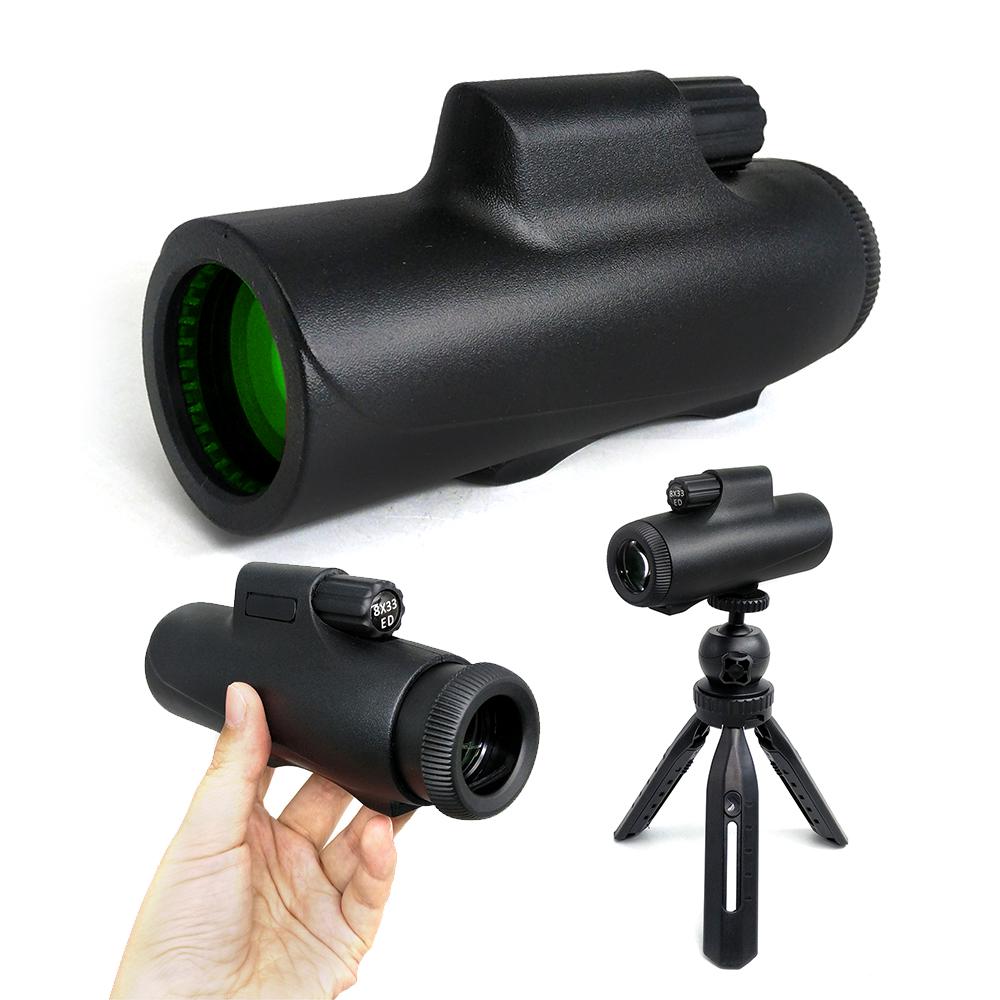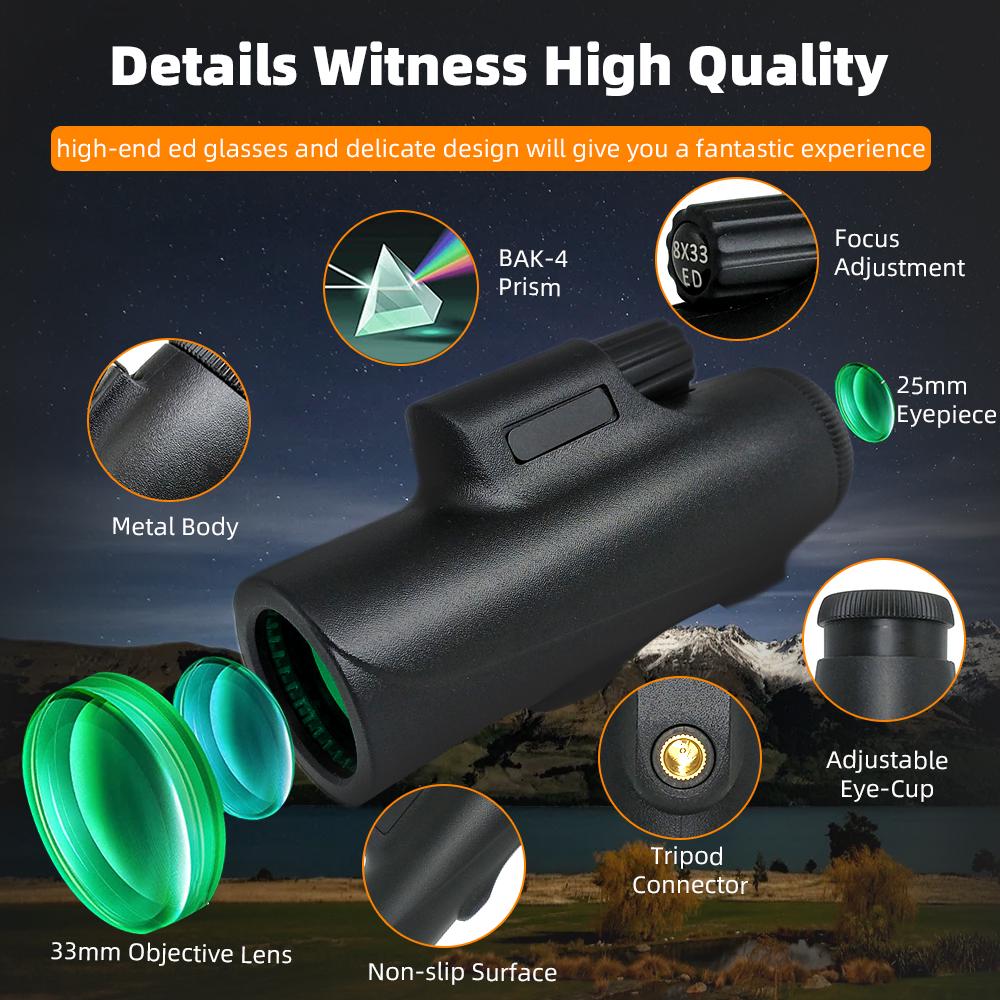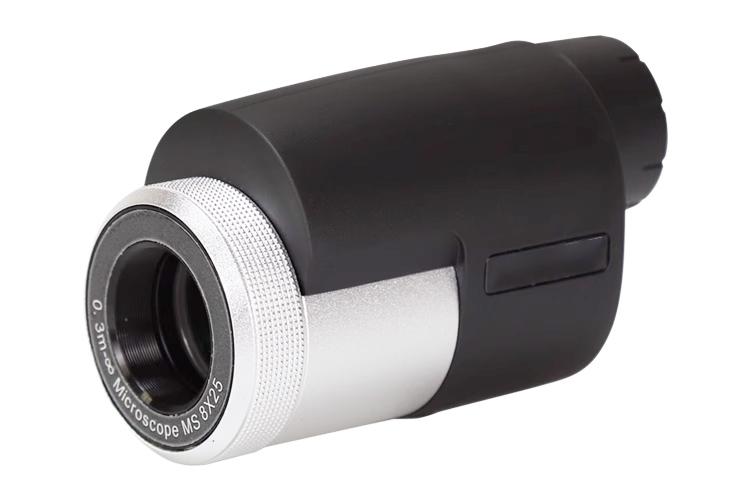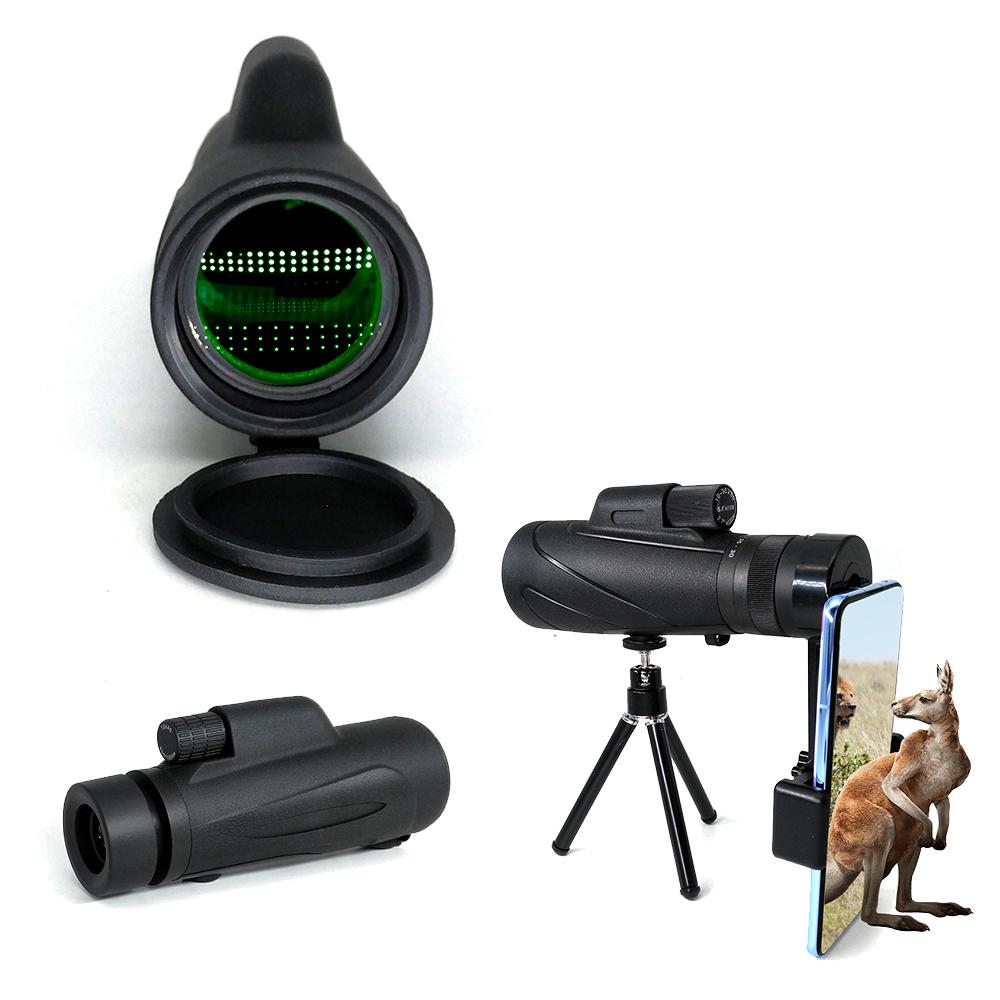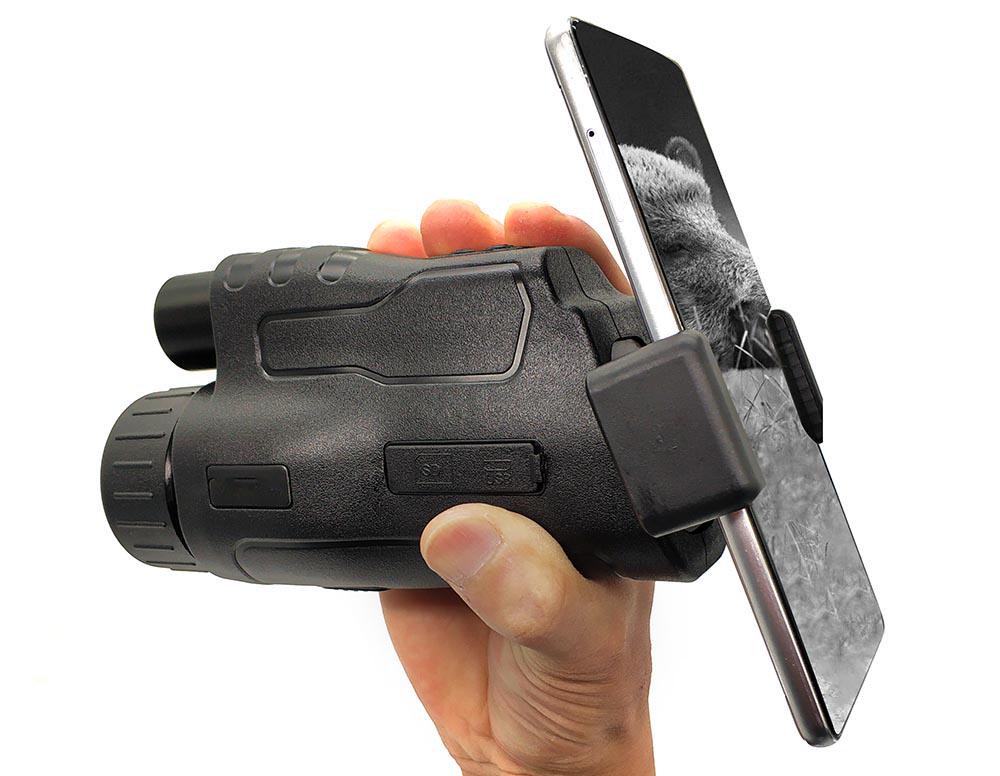Monoculars: Compact Power for Every Adventure
When you can’t carry a pair of bulky binoculars, a monocular is the perfect solution. Compact, lightweight, and easy to carry, monoculars are ideal for quick observations and outdoor activities. From the pen-sized Zeiss MiniQuick, which fits comfortably in a shirt pocket, to the high-performance Leica Monovid, monoculars offer impressive magnification with portability. Whether you’re watching the fine details of a butterfly or following the fast-paced action of a football game, monoculars provide remarkable clarity and ease of use.


Why Choose a Monocular?
Monoculars are particularly popular for outdoor enthusiasts, sports fans, and wildlife observers who need a compact, one-eyed optic for fast, on-the-go use. These small but powerful tools are easy to slip into a pocket, purse, or backpack, making them perfect for casual outings, birdwatching, or attending sports events where you need to zoom in quickly. Most folks go for monocular telescopes ’cause they’re easy to tote around and inexpensive. The tiniest ones are even smaller than your palm. You can just chuck these mini ones into your backpack or pants pocket, so you’re all set to check out any sudden targets whenever. The slightly bigger monoculars are also handy for outdoor jaunts like traveling or hiking. Most of ’em don’t have a hefty price tag, sometimes not even costing more than 10 bucks. And you can hook ’em up to your phone with a phone clip, which makes it a bit more fun. So, monocular telescopes are the most suitable choice for beginners who are just starting out with telescopes or for those who only use telescopes occasionally. Some of the most well-known models include the SECOZOOM YMTED01 8×33 Monocular, the Leica Monovid 8×20 Monocular, and the Zeiss Design & MiniQuick Line.
Choosing the Right Monocular
When selecting a monocular, it’s important to consider how you’ll be using it and where. If you need something ultra-portable for sports games or keeping in your car for impromptu birdwatching, models like the Zeiss 5×10 MiniQuick offer great functionality in a compact form. If you’re looking for a monocular that offers a wider field of view, the SECOZOOM YMTED01 8×33 Monocular is a versatile choice, and it can even be tripod-mounted for more stability and power. Its field of view attains an astounding 8.2 degrees, which endows it with the remarkable capability to swiftly and effortlessly capture targets. Such an expansive field of view not only facilitates a seamless and comfortable observation experience but also alleviates eye fatigue. Notably, it presents a flat field of view, ensuring the absence of any distortion. This aspect is of crucial significance as the fields of view of the majority of monocular telescopes typically exhibit minor deformations. While these slight aberrations may not substantially impede routine observations, in scenarios where meticulous examination of a specific target is requisite, the distorted field of view invariably emerges as a source of hindrance and inconvenience.

In addition, durability stands out as a prominent advantage for YMTED01 Monocular. Owing to the relatively uncomplicated structure of monocular telescopes, an inadvertent drop can potentially lead to the misalignment of the optical axis or even the shattering of lenses. To address this concern, the employment of high-quality plastics and robust metal fastenings is essential. Some military-grade telescopes, for instance, are encased in metal shells, which remarkably augment their resistance to impacts. Nevertheless, in the case of monocular telescopes, a judicious application of a limited quantity of metal components suffices to attain satisfactory anti-collision capabilities, ensuring their reliable performance and longevity even in the face of accidental mishaps.
Monoculars essentially work like one half of a pair of binoculars, with the same focusing mechanisms and similar fields of view. They are typically divided into two major types based on the prism system they use:
Porro Prism Monoculars
These use internal triangular prisms that reflect the image twice before it exits the monocular. They are often more affordable and provide excellent image quality, making them a great option for budget-conscious buyers. However, they tend to be bulkier and less durable in extreme conditions. An example is the . But, when the prices are the same, monocular telescopes with Porro prisms will offer a more excellent field of view. They are not expensive and also have good optical performance.
Roof Prism Monoculars
Roof prism monoculars utilize polygon-shaped prisms, offering a more compact and durable design. While lighter and more robust, they tend to come at a higher price. Premium examples include the Leica Monovid 8×20 Monocular and the Bushnell Legend Ultra HD 10×42.


For monoculars, the type of prism is not really that important. You just have to choose the look you like.
Magnification and Field of View
The main factor determining the size of the field of view is magnification. High magnification and large field of view are not possible at the same time. Monoculars typically offer fixed magnification between 5x and 10x, The maximum magnification of a handheld monocular telescope should not exceed 12 times, otherwise you need to use a tripod to assist.although some models provide variable zoom, allowing you to adjust the magnification for different situations. The higher the magnification, the more detailed the view, but it also results in a narrower field of view. Lower magnification monoculars are great for broader scenes, though they may sacrifice some fine detail.
Another important specification to consider is the exit pupil, which determines the amount of light transmitted to your eye. A larger exit pupil makes it easier to maintain a steady image, especially in low-light conditions.

Additional Features
Monoculars often come with additional features like waterproofing, rubberized armor, and specialized lens coatings to improve performance in varying weather conditions. For those who will be using their monoculars in the field, durability and weather resistance are essential factors. Many models also offer options for tripod mounting and phone clip, which can increase stability for high-magnification use.

There are also some monocular telescopes that are combined with digital technology. They’re called digital monocular telescopes, and actually, they’re a kind of night vision monocular. Usually, these night vision monoculars have a fixed optical magnification that’s between 6 and 10 times, and an electronic zoom that’s from 1 to 10 times. This can make the distance that you can observe much longer. Besides, they’ve got the night vision function, so you can use them to observe things and also record what you see. If you’ve got enough money in your budget, it’s definitely a good choice.
However, night vision monoculars also have a problem. The screen is too small, so you can’t see many details.
But there’s an interesting product from SECOZOOM called the NV540TEL. This night vision monocular doesn’t have a screen at all. Instead, it sends the pictures to your mobile phone’s screen through WiFi. This not only saves a lot of power for the night vision monocular but also lets you quickly record the pictures you see on your phone and share them on social media. You don’t need to go through the troublesome steps of getting the pictures out to a computer with a TF card or a data cable.
Another more useful thing is that you can put the night vision monocular in a place where you want to observe something, like beside a rabbit’s burrow. Then you can hide not far away with your phone. Through your phone, you can see the pictures that the night vision monocular takes in real time, and you won’t scare the rabbit. It can separate the night vision monocular from the person who’s observing. This is really a useful function for outdoor adventures.
SECOZOOM Optics: Your Monocular Destination
SECOZOOM is A prominent OEM brand manufacturer in China, has established a remarkable reputation in the market. As a prominent OEM brand manufacturer in China, it has painstakingly carved out a remarkable reputation that resonates throughout the market. The proof lies in the fact that Many of the best-selling optical telescope products on Amazon are OEM products of SECOZOOM.

Yet, what truly cements SECOZOOM’s distinctiveness is its unparalleled prowess as a supply chain integrator. It has deftly mastered the intricate art of sourcing and synergizing products from an expansive and diverse ecosystem of optical factories. These manufacturing facilities are strategically dispersed across multiple regions, with eastern China being a linchpin in its supply chain network. Renowned for its state-of-the-art industrial infrastructure and technological vanguard in the optical realm, eastern China serves as a breeding ground for innovation and quality production.

Moreover, SECOZOOM’s supply chain extends its reach to include vibrant regions like Yunnan and Chongqing, nestled along the Yangtze River Economic Belt. This geographical diversity not only enriches its product portfolio but also endows it with unique advantages in terms of cost-effective sourcing and access to specialized manufacturing capabilities.
Thanks to its formidable supply chain integration capabilities, SECOZOOM functions as a veritable one-stop destination for optical instruments. Whether you’re an amateur astronomy enthusiast yearning for a compact, handheld telescope to explore the night sky’s wonders or a seasoned professional demanding high-precision, research-grade equipment, SECOZOOM has you covered. Its extensive catalog ensures that customers can lay their hands on virtually any optical scope they envision, with unwavering confidence.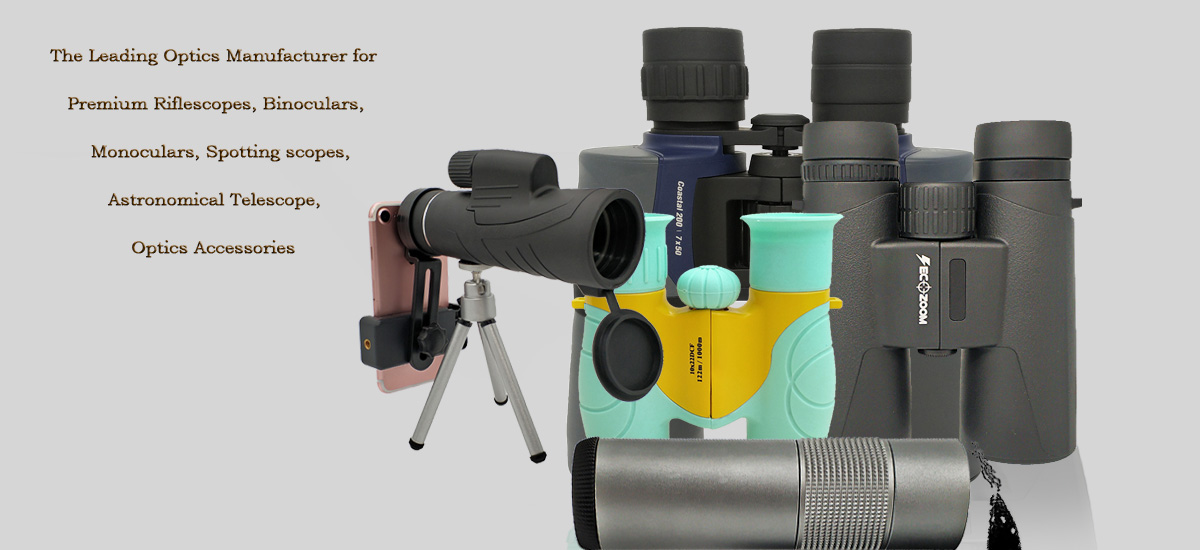
This holistic supply chain strategy isn’t just about quantity; it’s a trifecta of benefits. By meticulously orchestrating every link in the chain, SECOZOOM not only offers an extensive variety of products but also manages to uphold competitive pricing, adhere to streamlined production schedules, and enforce stringent quality benchmarks. In doing so, it has firmly entrenched itself as the undisputed leader in the optical manufacturing and supply chain arena, setting the gold standard for others to aspire to.



